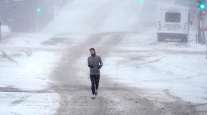Staff Reporter
States Feel Brunt of Driver Shortage in Search for Snowplow Drivers

State departments of transportation seeking equipment operators to take on temporary seasonal work have not been able to avoid the driver shortage that the trucking industry grapples with daily.
Every year, states across the Northeast and Midwest look for hundreds of seasonal workers to help contend with winter weather. Four of them — Iowa, Michigan, Pennsylvania and South Dakota — have hired fewer commercial driver license holders than desired to operate snowplows.
Last year, for example, Pennsylvania DOT sought 873 CDL holders to operate equipment but ended up hiring 620 CDL holders. Iowa DOT, which generally seeks 600 people to help the regular staff operate snowplows, hired 535. South Dakota DOT filled 64 of the 71 seasonal positions that it advertised; they joined a group of 51 past seasonal employees who had already agreed to return for temporary work. Michigan DOT had trouble finding 90 workers to drive plows.
The agencies have roughly the same goal for the number of seasonal workers this winter.
“There was still plenty of unrealized opportunity last year for job-seekers, which we anticipate will be the case this winter as well,” PennDOT spokesman Rich Kirkpatrick told Transport Topics. “Unfortunately, we have found that increased recruitment is needed in order to increase the volume of applicants for the winter program. As a result, we have gone from a couple recruiters last year to a recruiting staff of five.”
The scarcity of snowplow operators echoes the industrywide shortage of truck drivers. American Trucking Associations this year has reported the shortage at more than 50,000 drivers.
Richard Nelson, coordinator of the American Association of State Highway and Transportation Officials’ Snow and Ice Cooperative Program, said the general lack of drivers coupled with the long hours and frigid work conditions contributes to state DOTs’ struggles to find workers.

“There’s a real shortage of folks out there to fill those seasonal positions,” Nelson said. “Trying to find the folks that have the CDLs, that want to work in terrible conditions all hours of the day and night, it’s kind of a hard thing to round them all up.”
Pay for snowplow operators ranges from $15 hourly (in Pennsylvania and South Dakota) to $22 hourly (in Michigan).
Iowa DOT spokeswoman Andrea Henry said that hours are long and varied because snow removal is “24-hours, seven days a week.”
Elwynn Taylor, an Iowa State University professor who specializes in climatology, said Midwestern winters can be severe because bitterly cold Canadian air and moisture from the Gulf of Mexico occasionally clash, resulting in freezing rain and thunder snow.
Taylor, based in Ames, which is 30 miles north of Des Moines, explained that severe winter weather generally follows a 60-year cycle. Ames gets about 28 inches of snow a year, according to the National Weather Service.
“We expect to have our winters in the next eight to 10 years be harsher than they’ve been in the past 20 or 30 years,” Taylor said.

Taylor
Minnesota has had success managing its snow removal. Its DOT spokeswoman Susan Roe said the agency typically avoids operator shortages by starting recruitment efforts in the summer and repeatedly advertising vacant posts. MnDOT hired 241 temporary snow plow drivers last year to supplement its staff of 1,500 full-time operators.
If any of MnDOT’s eight districts encounter shortages during snow events, Roe said other agency offices send drivers who work overtime if need be. The Minnesota Department of Natural Resources reports that the northern districts can receive 70 inches of snowfall a year.
“We manage to get out there in the different communities,” Roe said. “We spread the word and we eventually get what we need.”
PennDOT encourages potential recruits by pointing out that temporary winter maintenance workers may later join the agency as permanent employees. Kirkpatrick said PennDOT sees a 33% rate of seasonal-to-permanent promotions.
Nelson, who worked at the Nevada DOT for 30 years, said that state government agencies frequently lose employees to the private sector, which often offers higher pay. He recognized the labor shortage as an issue at both the temporary and permanent levels.
“You bring them on, you get them trained up, they get some experience with their CDL and then they’re off to drive for commercial outfits,” Nelson said. “Really the states have become a training ground for folks and it’s hard to keep them in the saddle.”




